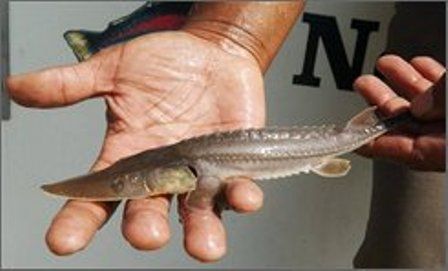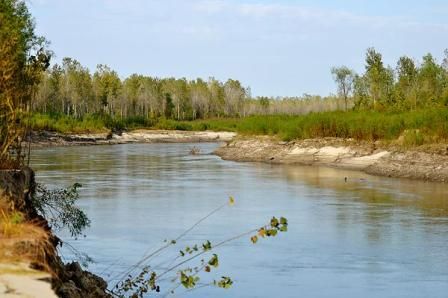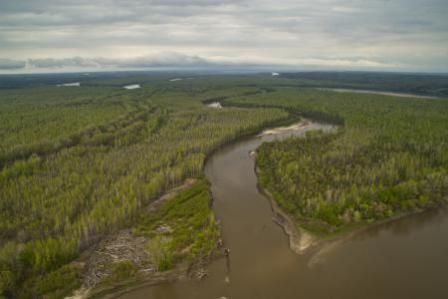|
|
|
|
|
Volume VI, Issue 25
| June 18, 2012 |
|
|
|
|
Does the Missouri River Need More Sediment
by David Casaletto
Ozarks Water Watch - Executive Director
While the Missouri River is far outside the Upper White River Basin Watershed, the decision whether or not to allow the Corps to put a large amount of sediment into the river is becoming more twisted than the river channel itself. The Corps finds itself in the center of trying to comply with two federal laws that appear to be in conflict: the Endangered Species Act versus the Clean Water Act. This story illustrates how complex these issues can become.
The Corps is proposing to build an additional mile-long shallow water habitat chute in Jameson Island located in Arrow Rock bottoms on the Missouri River. The project is in cooperation with the U.S. Fish and Wildlife Service on their existing public land to mitigate a portion of aquatic habitat that was lost as the result of the construction of the Army Corps' Missouri River Bank Stabilization and Navigation Project through construction of a side channel chute and a backwater. The project would restore the dynamic river processes for the benefit of native fish and wildlife species, including the endangered pallid sturgeon. At issue, however, is what to do with the soil excavated after building the 200-foot wide chute. The Corps plan includes four alternatives, but the Corps recommends the fourth alternative: excavating the soil, incorporating it into a slurry mix and integrating it into the river.
 | | Endangered Pallid Sturgeon. |
Back in 2008, the Clean Water Commission had ordered the Corps to quit putting soil into the river. At the time, the commission expressed concerns the nutrients, such as phosphorus, would exacerbate nutrient and sediment pollution both within the river and the Gulf of Mexico. The corps then halted the project in Missouri and commissioned a National Academy of Science study to look into the affects of dumping soil into the river. The study found the Missouri River carries only 20 percent of the sediment load it once did, causing loss of habitat for native fish and bird species, including the pallid sturgeon and least tern. The study also said the dumping did not have a significant impact on hypoxia in the gulf. As a result of the study, the Corps is requesting to resume the project.
 | | Jameson Island, Missouri River . |
At a joint public hearing in Jefferson City Monday, June 11, the Missouri Clean Water Commission and U.S. Army Corps of Engineers listened to over 30 speakers address the corps' request for a water quality permit that would enable the Corps to dump soil from the new chute extension at Jameson Island into the Missouri River. While almost all of the speakers were in favor of the project moving forward, they were divided on the issue of how to handle the excavated soil.
In an interesting twist, most of those speaking at the hearing against the Corps plan to put excavated soil back into the river represented agriculture. They feel the plan is a double standard, allowing the Corps to dump soil that is naturally rich in nutrients such as phosphorous into the river when the same act by a private citizen would be considered illegal. Most of those speakers proposed the Corps use the third proposed alternative, which includes broadcasting the excavated soil on part of the 1,800 acre site and seeding it down so the soil does not end up in the river. While this alternative seems to make sense, a representative from the Corps said alternative three, which calls for clearing 800 feet of forest and wetlands and placing two 15-feet high stockpiles on either side of the chute, would be "more environmentally damaging to riparian timber, wetlands and fish and wildlife resources."
 | | Jameson Island Chute, Missouri River. |
Many of those speaking in favor of the Corps plan represented environmental groups that included the Sierra Club, the Missouri Parks Association, the Audubon Society and the Missouri Coalition for the Environment. Many cited the National Academy of Science study as support for their opinions. Lorin Crandal, the clean water director for the Missouri Coalition for the Environment stated, "The river is sediment starved and that is a scientific fact."
Now the Clean Water Commission has to decide and will be doing so soon. In the meantime, they are accepting written comments until June 30th. Comments can be sent to: Missouri Clean Water Commission, Missouri Department of Natural Resources, P.O. Box 176, Jefferson City, MO 65102. You can also view the complete June 11th hearing on YouTube. The YouTube links are listed at the bottom of this Marshall Democrat-News story.
The Missouri River long ago was nicknamed the Big Muddy for a reason. It may be wrong to think man or the Clean Water Act could or should try to change that.
|
____________________________________
Quote of the Week "You must be the change you wish to see in the world."
~ Mahatma Gandhi
________________________________________ |
|
Farmers testify in front of Missouri Clean Water Commission
Tuesday, June 12, 2012
By MARCIA GORRELL/Staff writer/Marshall Democrat-News

At a joint public hearing in Jefferson City Monday, June 11, the Missouri Clean Water Commission and U.S. Army Corps of Engineers listened for more than four hours as approximately 40 speakers addressed the corps' request for a water quality permit that would enable it to dump soil from a new chute extension at Jameson Island into the Missouri River. The hearing, held at the Department of National Resource Building in Jefferson City, drew a standing-room-only crowd, including a number of people from Saline County, where the project in question is located. Speakers and attendees traveled from as far away as northeast and northwest Missouri.
The corps proposes to build an additional mile-long shallow water habitat chute on Jameson Island located in the Arrow Rock bottoms. Jameson Island is part of the U.S. Fish and Wildlife Service Big Muddy National Fish and Wildlife refuge. The Jameson Island public area includes 1,871 acres of bottom land forest, riparian areas and wetlands. The proposed project also includes a large diversion structure that would ensure the flow coming downstream diverts into the new channel. The project will help alleviate a large erosion problem directly across the river from the first chute, where the river is widening and causing damage to a levee owned by Howard County District No. 3.
The current chute and the accumulated sediment from it also hampers towboats navigating the main channel near Jameson Island. The majority of speakers at the hearing were in favor of the project, urging the corps to get it under way. At issue, however, is what to do with the soil excavated after building the 200-foot wide chute. The corps plan includes four alternatives, but the corps recommends the fourth alternative: excavating the soil, incorporating it into a slurry mix and integrating it into the river.
To read more, Click: HERE.
________________________________
|
|
CAUTION: Energy Saving Light Bulbs
Subdivision Trustees - St. Louis Metro Area Blog
By now, we have all seen them. We probably all have some in our homes. We most certainly have come into contact with them in the homes to which we respond. I am talking about energy-saving light bulbs. They have many different names; compact fluorescent lamp (CFL), compact fluorescent light, and compact fluorescent tube, all describe a fluorescent lamp designed to replace an incandescent lamp. Compared to their incandescent brothers producing the same amount of visible light, CFLs consume less power (from 1/5 to 1/3) and have a longer service life (8 to 15 times).

But the news in our quest to be better stewards of our planet is not all good. These CFLs have a small electronic ballast in their base. There is a fire hazard associated with these ballasts, but that is a conversation for another day. Let's talk about another danger posed by these "green" lamps: mercury exposure and poisoning.
Like all fluorescent lamps, CFLs contain mercury. This fact not only complicates their disposal under normal conditions, the problem is exacerbated when the lamp is broken and the mercury is allowed "out of its box." The symptoms of mercury poisoning typically include sensory impairment (vision, hearing, and speech), a lack of coordination, skin discoloration, tingling, itching, burning or pain, and desquamation (shedding of skin).
To read more, Click: HERE.
_______________________________________
|
|
WaterSense 2011 Annual Accomplishments Announced
WaterSense, an EPA partnership program that helps Americans protect the nation's water supply by offering people simple ways to save water, is announcing its 2011 program accomplishments. Since the program's inception in 2006, WaterSense-labeled products have helped Americans save $4.7 billion in water and energy bills and 287 billion gallons of water. That amount of water could supply all the homes in Georgia or Arizona for a year. WaterSense-labeled products have also saved 38.4 billion kilowatt hours of electricity since 2006 by reducing the amount of energy needed to heat, pump, and treat water. That's the equivalent amount of electricity needed to power more than 3.6 million homes for a year. With these energy savings, WaterSense has helped eliminate 13 million metric tons of greenhouse gas emissions, the equivalent of planting nearly 350 million trees. WaterSense owes this success to the more than 2,600 utility, government, nonprofit, manufacturer, retail, distributor, builder and irrigation partners who joined with EPA to help promote the WaterSense label and spread the word about the importance of water efficiency.
To visit EPA website, Click: HERE.
|
|
|
|
Contact Info
OZARKS WATER WATCH MISSOURI OFFICE ARKANSAS OFFICE
David Casaletto, President PO Box 636, 2 Kissee Ave., Ste. C 1200 W. Walnut, Ste. 3405
(417) 739-5001 Kimberling City, MO 65686 Rogers, AR 72756
contact@ozarkswaterwatch.org
|
|
|
|
|